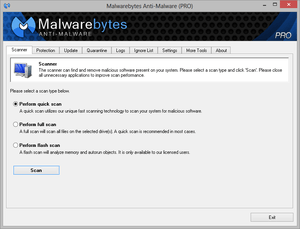Malwarebytes' Anti-Malware
|
| |
 Malwarebytes' Anti-Malware version 1.46 running under Windows 8 | |
| Developer(s) | Malwarebytes Corporation |
|---|---|
| Stable release | 1.75.0.1300 / April 9, 2013[1] |
| Preview release | 2.00 / January 29, 2014[2] |
| Operating system | Microsoft Windows |
| Size | 10.1 MB[3] |
| Available in | 36 languages |
| Type | Anti-malware |
| License |
Proprietary Free: Freeware Pro: Commercial Enterprise: TBA |
| Website | www.malwarebytes.org |
Malwarebytes' Anti-Malware (MBAM) is an application for computers running under the Microsoft Windows operating system that finds and removes malware.[4] Made by Malwarebytes Corporation, it was first released in January 2008. It is available in a free version, which scans for and removes malware when started manually, and a paid version, which additionally provides scheduled scans, real-time protection and a flash memory scanner. Starting with version 1.75, MBAM scans files contained within archive files.
Overview
MBAM claims to find malware that many other anti-virus and anti-spyware programs miss, including rogue security software, adware, and spyware. MBAM scans in batch mode, rather than scanning all files opened, reducing interference if on-demand anti-malware software is also running on the computer.[5][6]
MBAM is available in both a free and a paid version.[4] The free version can be run by the user when required. The paid version can perform scheduled scans, automatically scan files when opened, block IP addresses of malicious web sites, and quickly scan only open services, programs and device drivers.[7]
MBAM is available with a user interface in many languages.[3] A Malwarebytes Anti-Rootkit program (beta v1.01.0.1021 as of March 2013) and a startup manager are available for download. [8]
Reception
- PC World's Preston Gralla wrote that "Using Malwarebytes' Anti-Malware is simplicity itself".[4]
- CNET in 2008 cited Malwarebytes as being useful against the MS Antivirus malware,[9] and also awarded it an April 2009 Editor's Choice, along with 25 other computer applications.[7][10]
- Mark Gibbs of Network World gave Malwarebytes' Anti-Malware 4 stars out of 5 in January 2009 and wrote that "It does the job and only the lack of a detailed explanation of what it has found stops it from getting 5 out of 5".[11]
- PC Magazine gave Malwarebytes' Anti-Malware 3.5 stars out of 5 in May 2010, saying that although it was good at removing malware and scareware, it fell short on removing keyloggers and rootkits.[12]
- The usefulness of Malwarebytes for enterprise use has been questioned, on the basis that it is particularly good at removing, rather than detecting malware, but adds expense and complexity, and consumes computer resources and reduces performance. For the enterprise, malware removal is usually unimportant, as an infected machine is typically re-imaged from a standard desktop image, discarding the infected system.[13]
- Botcrawl.com in 2012 cited Malwarebytes as being useful for removing reveton ransomware.[14]
Dispute with IObit
On November 2, 2009, Malwarebytes accused[15] rival IObit of incorporating the database of Malwarebytes' Anti-Malware (and several products from other vendors, which were not named) in its security software IObit Security 360. IObit denied the accusation and stated that the database is based on user submissions, and sometimes the same signature names that are in Malwarebytes get placed in the results. They said they did not have time to filter out the signature names that are similar to Malwarebytes. IObit also stated that Malwarebytes does not have convincing proof, and promised that the databases were not stolen.[16] After the declaration from IObit, Malwarebytes replied that they are not convinced of the argument from IObit.[17][18] Malwarebytes claims to have served DMCA infringement notices against CNET, Download.com and MajorGeeks.com in order to have the download sites remove the IObit software. IObit said that as of version 1.3, their database has been updated to address those accusations of intellectual property theft made earlier by Malwarebytes.[19][20]
See also
- List of antivirus software
References
- ↑ "Malwarebytes Anti-Malware 1.75 Released!". MalwareBytes. Retrieved 2013-04-14.
- ↑ "Malwarebytes Anti-Malware 2.00 Beta Test". MalwareBytes. Retrieved 2014-02-02.
- ↑ 3.0 3.1 "Malwarebytes Anti-Malware PRO". Retrieved 2012-04-17.
- ↑ 4.0 4.1 4.2 "Editorial review of Malwarebytes' Anti-Malware". PC World. Retrieved 2009-08-18.
- ↑ "Malwarebytes Corporation". MalwareBytes. Retrieved 2009-08-18.
- ↑ Neil J. Rubenking (2009-12-02). "Free Antivirus and Antispyware". PC Magazine. Retrieved 2009-12-09.
- ↑ 7.0 7.1 Seth Rosenblatt (2009-02-10). "Malwarebytes Anti-Malware". Download.cnet.com. Retrieved 2009-12-05.
- ↑ "Malwarebytes Anti-Rootkit". Softpedia. Retrieved 2013-01-28.
- ↑ Rosenblatt, Seth (2008-09-24). "Take a 'byte' out of malware". The Download Blog. CNET. Retrieved 2008-11-27.
- ↑ "CNET Editors' Choice Awards 2009 Winners". Reviews.cnet.com. 2009-06-02. Retrieved 2009-12-05.
- ↑ Gibbs, Mark (2009-01-07). "Malwarebytes finds pesky Trojan". Gearhead (Network World). p. 2. Retrieved 2009-01-08.
- ↑ Rubenking, Neil J. (2010-05-07). "Malwarebytes' Anti-Malware 1.46". PC Magazine. Retrieved 2010-06-03.
- ↑ eSecurity Planet - Review: Malwarebytes Enterprise Edition, 24 October 2012
- ↑ Doyle, Sean (2012-07-05). "How To Remove The FBI Virus (FBI Moneypak Ransomware) – Fake FBI Malware Removal Options". Malware Removal. Botcrawl.com. Retrieved 2012-07-05.
- ↑ IOBit Steals Malwarebytes' Intellectual Property.
- ↑ Declaration from IObit.
- ↑ IOBit’s Denial of Theft Unconvincing.
- ↑ Malwarebytes accuses rival of software theft. CNET.
- ↑ IObit Malware Fighter.
- ↑